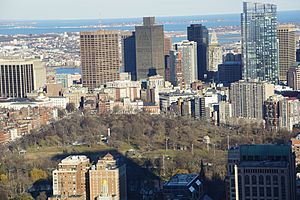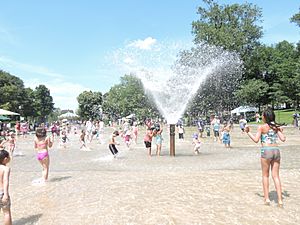Boston Common facts for kids
|
Boston Common
|
|

View of the water celebration on Boston Common on October 25, 1848
|
|
| Lua error in Module:Location_map at line 420: attempt to index field 'wikibase' (a nil value). | |
| Location | Boston, Massachusetts |
|---|---|
| Area | 50 acres (200,000 m2) |
| Built | 1634 |
| Architect | Multiple, including Augustus St. Gaudens |
| NRHP reference No. | 72000144 (original) 87000760 (new) |
Quick facts for kids Significant dates |
|
| Added to NRHP | July 12, 1972 (original, in NRHP also including Boston Public Garden) February 27, 1987 (new, in NHL of Boston Common alone) |
| Designated NHLD | February 27, 1987 |
Boston Common, also called the Common, is a large public park in downtown Boston, Massachusetts. It started in 1634, making it the oldest city park in the United States. The Common covers about 50 acres (20 hectares) of land. It is surrounded by important streets like Tremont Street, Park Street, Beacon Street, Charles Street, and Boylston Street.
Boston Common is part of the Emerald Necklace. This is a chain of parks and green spaces that stretches from the Common all the way south to Franklin Park. You can find a visitors' center for all of Boston on the Tremont Street side of the park.
The Central Burying Ground is on the Boylston Street side of Boston Common. Many famous people are buried there. These include the artist Gilbert Stuart and the composer William Billings. Samuel Sprague, who was part of the Boston Tea Party and fought in the American Revolutionary War, is also buried there. His son, Charles Sprague, one of America's first poets, rests there too. In 1977, the Common was named a Boston Landmark.
Contents
History of Boston Common

Boston Common was once much larger. It included the area where the Granary Burying Ground is today. This burying ground was created in 1660. In 1662, this land was separated from the Common.
The Common's use has changed a lot over the years. It was first owned by William Blaxton, the first European settler in Boston. In 1634, the Puritan founders of the Massachusetts Bay Colony bought it from him.
From Pasture to Park
In the 1630s, many families used the Common as a place for their cows to graze. But too many cows were brought in, which caused overgrazing. This meant the grass was eaten too much and couldn't grow back well. This problem is sometimes called the "tragedy of the commons".
To fix this, grazing was limited to 70 cows at a time in 1646. Cows continued to graze on the Common until 1830. That year, Mayor Harrison Gray Otis officially banned them.
Important Events at the Common
The Common has been a site for many important historical moments. Before the American Revolutionary War, the British army used it as a camp. They marched from here to the Battles of Lexington and Concord.
In 1713, about 200 citizens protested on the Common. They were upset about a food shortage in the city. They later attacked the ships and warehouses of a rich merchant who was sending grain away.
By 1830, the Common truly became a park. An iron fence was built around it in 1836. This fence enclosed its five walking paths, called malls. The first path, Tremont Mall, was created in 1728. This was similar to St. James's Park in London. Some people believe Boston Common might be the world's first public urban park. This is because its improvements happened before other famous parks in England.
Modern Changes and Protests
The area of Boston Common near Charles Street was once a dumping ground. It was also a wet, smelly marsh. This kept visitors away. Plans to fix this area were made for a long time. But moving all the soil needed was very expensive.
This changed in 1895. The digging for the Tremont Street subway provided a huge amount of soil. This soil was used to raise and improve the Charles Street sides of both Boston Common and the Public Garden.
The Common has also been a place for protests. In 1965, people gathered there to protest the Vietnam War. In 1969, a much larger protest took place with 100,000 people.
Today, the Common is a busy public park. It hosts concerts, protests, and softball games. You can even go ice skating on the Frog Pond in winter. Famous people like Martin Luther King Jr. and Pope John Paul II have given speeches here. Judy Garland held her biggest concert ever on the Common in 1967.
In 1987, Boston Common was named a U.S. National Historic Landmark. The City of Boston manages the park. A group called Friends of the Public Garden helps care for it and raises money for events.
In 2006, the Common set a world record. Over 30,000 Jack-o'-lanterns were lit at the same time during the Life is good Pumpkin Festival.
What to See at Boston Common
Park Areas
Boston Common is at the southern end of Beacon Hill. It is also the southern end of Boston's Freedom Trail.
The Boston Common Frog Pond is in the middle of the park. In winter, it's an ice skating rink. In spring and fall, it's a calm reflecting pool. In summer, it becomes a spray pool and has a children's carousel.
Softball fields are in the southwest part of the Common. The western part of the park is a large grassy area. This is where the biggest events are held. There's a parking garage hidden underneath this area. A special stone slab here remembers Pope John Paul II's visit in 1979. He held a mass for about 400,000 people that day.
Archaeologists have found signs of Native American life on the Common. These sites show people lived here as far back as 8,500 years ago.
Every year since 1971, the Province of Nova Scotia donates the Boston Christmas Tree. This is a thank-you gift to Boston. It's for the help Boston sent after the Halifax Explosion in 1917.
Monuments and Structures
- The Boston Common Tablet is near Park Street and Tremont Street.
- The Declaration of Independence Tablet is also here.
- A plaque marks the spot of the Great Elm tree. This tree was important for liberty and was used for hangings. It fell in a storm in 1876.
- The Robert Gould Shaw Memorial honors Robert Gould Shaw and the African American 54th Massachusetts Volunteer Infantry. It stands at Beacon and Park Streets, across from the State House.
- The Soldiers and Sailors Monument is a tall column on Flag Staff Hill. It remembers those who died in the Civil War.
- The Boston Massacre Monument was dedicated in 1888.
- The Oneida Football Club Monument marks the Common as the place where the first organized football games in the U.S. were played in 1862.
- Brewer Fountain is near Park and Tremont Streets.
- Boylston and Park Street stations are under the park. They were the first two subway stations in the United States, opening in 1897.
- Parkman Bandstand, in the eastern part of the park, is used for music and plays.
- Parkman Plaza has statues representing Industry, Learning, and Religion.
-
Boston Massacre Memorial
Buildings Near the Common
- The Massachusetts State House is across Beacon Street from the north side of the Common.
- The Boston Public Garden, a beautiful landscaped park, is west of the Common across Charles Street.
- The Masonic Grand Lodge of Massachusetts building is across from the south corner of the Common.
- Emerson College campus is also across from the south corner.
- Suffolk University has a dormitory on Tremont Street, across from the southeast side.
Fun Events at the Common
Many events happen regularly at Boston Common:
- The Frog Pond Skating Spectacular, with skaters from The Skating Club of Boston, happens during the Boston Tree Lighting and First Night Boston.
- The Commonwealth Shakespeare Company performs Shakespeare plays on the Common.
- The Boston Lyric Opera has outdoor opera shows.
- The Ancient Fishweir Project holds an installation event.
- The lighting of the Christmas tree from Halifax, Nova Scotia, is a popular event.
- A fireworks display takes place on December 31 as part of Boston's First Night celebration.
See also
 In Spanish: Boston Common para niños
In Spanish: Boston Common para niños





















